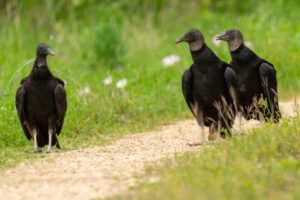
Two recent AgriLife Extension publications provide citizens with knowledge and tools to address potential conflicts between humans and vultures. (Texas A&M AgriLife photo by Michael Miller)
What can Texans do when their neighbors are unsightly, smelly and have the habit of relieving themselves wherever they like?
If those neighbors happen to be one of the state’s two vulture species, they can call on the expertise of wildlife specialists with the Texas A&M AgriLife Extension Service and Texas Wildlife Services.
“The range and population of turkey vultures and black vultures has expanded over the past decade, leading to increased interactions with humans in both urban and rural settings,” said Mikayla Killam, AgriLife Extension wildlife program specialist with the Department of Rangeland, Wildlife and Fisheries Management in Texas A&M’s College of Agriculture and Life Sciences.
While vultures don’t pose a direct threat to humans, some circumstances require intervention.
Killam said this increase in potential conflict was the driving force behind the development of two recent AgriLife Extension publications available at https://tx.ag/VultureConflict. The resources educate Texans on how to address and resolve potential clashes with vultures while also adhering to federal law protecting vultures and other migratory bird species.
Conflicts unique to urban and rural environments
Killam said one way to address encroachment by vultures is to reduce attractants.
“As with other wildlife species, vultures are seeking resources,” Killam said. “In many cases, this is food.”
While vultures rely on carrion as a primary food source, urban environments can provide abundant sustenance in the form of food waste.
“Take, for example, dumpsters located outside of restaurants or school cafeterias,” Killam said. “If these aren’t properly secured, they can become a huge attractant for vultures.”
Killam said refuse is such an attractant that there are regulations in place limiting the proximity of garbage dumps to airports in an effort to prevent airplane and avian collisions.
Buildings and transmission towers also provide valuable roosting spaces that can support large gatherings of vultures—oftentimes numbering in the hundreds. The sheer amount of excrement that can collect at these roosting sites is a health concern when located in areas of human activity.
In addition to their roosting habits, preferences for nesting sites during spring months can lead to conflict.
“I’ve seen vultures lay eggs right outside the doors of an urban office building or in a child’s playhouse in a suburban backyard,” said Linda Tschirhart-Hejl, district supervisor with Texas Wildlife Services.
Housed within AgriLife Extension, Texas Wildlife Services is a state- and federally-funded agency dedicated to resolving wildlife conflict to protect agriculture, property and natural resources while also safeguarding human health and safety.
“Like any parent, vultures are protective of their young—they may not fly in your face, but they can show aggression,” Tschirhart-Hejl said.
Vultures are protected under the Migratory Bird Treaty Act, which prohibits the killing, possession, import, export, sale or purchase of any migratory bird or its parts. This also includes the nests, eggs or chicks of protected birds.
In rural areas, vultures have been known to predate young or vulnerable livestock, which is of great concern during calving, lambing and kidding season.
“Black vultures are typically the main culprit in this,” Tschirhart-Hejl said. “This behavior can even result in indirect livestock death as a result of a cow accidentally trampling its calf while trying to protect it.”
Implementing solutions
Although they are protected by the Migratory Bird Act, there are numerous non-damaging actions residents and landowners can take to prevent conflict from escalating.
“The first action is just taking steps to make an area less desirable,” Killam said.
This includes removing or securing potential food sources, such as dumpsters. Or, in the case of roadkill or livestock mortality, proper disposal of carcasses.
“Ranchers can be proactive prior to calving, lambing or kidding season by making sure the area does not have any vulture attractants,” Tschirhart-Hejl said. “Remove any dead trees or brush piles that can act as roosting or loafing sites, and if there is any type of food attractant in the birthing area, make sure it is also removed.”
In the event a vulture conflict involves roosting on a structure, exclusion devices such as bird spikes, electric perch deterrents or other obstructions can be effective.
If the conflict continues once attractants are removed, Killam said aversive conditioning can be implemented. This can include the placement of artificial dead vulture effigies, laser lights or pyrotechnics.
“The point of harassment is that you can take action to deter the vulture, but you’re not harming the animal,” Killam said.
Only in special circumstances is lethal removal an option, and this may only be done after receiving a Migratory Bird Depredation Permit granted by the U.S. Fish and Wildlife Service.
“If someone is encountering an issue, we encourage them to contact Wildlife Services,” Tschirhart-Hejl said. “We’re the agency that deals with nuisance wildlife and can assist landowners in developing a damage management plan.”
Although vulture conflicts can arise, Killam said it’s important to not forget the beneficial role vultures and other native wildlife play in the ecosystem.
“One thing we try to emphasize is that this is a wildlife damage management plan—not a pest management plan,” she said. “While they may be annoying at times, they’re a part of our ecosystem and are doing valuable work. Our goal is to manage conflict, which ultimately is managing coexistence.”

 .
.